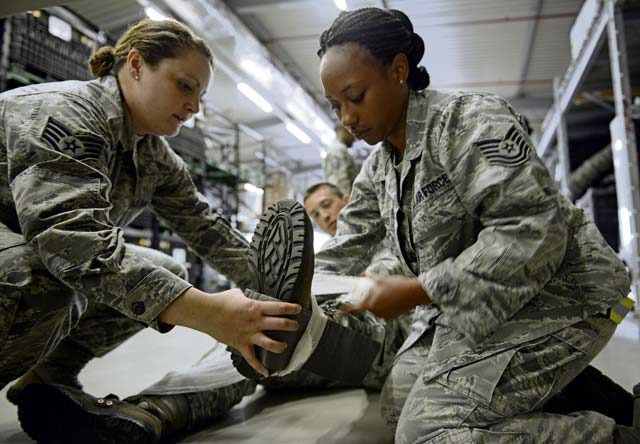
Members of the 86th Medical Group participated in a self-aid and buddy care rodeo
July 10 on Ramstein.
The rodeo was designed to give medical personnel a hands-on refresher of the potentially life-saving techniques taught in SABC.
“I feel like I’m back in boot camp where I learned it for the first time, but I get it more,” said Airman 1st Class Kelsey Kellner, 86th Dental Squadron dental assistant. “When they try to explain it now, it definitely makes more sense.”
The Airmen went through several stations and discussed proper use of the tools provided and what to do if tools aren’t available in an emergency.
“Even though I’m a dental assistant, anyone can be required to do this anywhere,” Kellner said. “It’s very valuable training. Saving someone’s life is probably the biggest treasure you could ask for.”
At the airway management station, the Airmen practiced several techniques of opening an injured individual’s airway, including the head-tilt/chin-lift, the jaw thrust and inserting a nasopharyngeal airway tube. They also discussed which techniques to use and not use if there are signs of spinal injury. Airway management is often the main focus of first responders as long periods with little to no oxygen can be detrimental.
Members also had hands-on practice in controlling life-threatening bleeding by applying pressure directly to the wound or pressure points, elevating extremities above the heart — if there are no head, neck or spinal injuries — and, finally, using either a tourniquet or combat gauze.
“In boot camp they tell you how to do this stuff, but you don’t get as much hands-on training,” Kellner said. “When we started here I was excited and nervous, but then I calmed down and started to think and rely on what I’ve been taught. The class here is much more extensive.”
Airmen practiced splinting and securing fractures. They also discussed that, with open fractures, bleeding control takes precedence.
At the litter carry station, members trained loading and moving patients on a litter. As it is sometimes necessary to move an injured person, it is important to know how to do so without causing additional damage.
During the refresher course, Airmen from various medical fields were able to build their
skills as well as their esprit de corps among each other.
“The camaraderie is great, because people are like, ‘Oh, you don’t know how to do that?
Let me help you with that,’” Kellner said. “We’re all here for a common reason, and that’s definitely great.”


